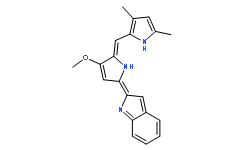| In Vitro: |
Obatoclax (GX15-070) inhibits BCL-2, BCL-XL, MCL-1, BCL-w, A1, and BCL-b with Ki values≈1-7 μM[2]. Obatoclax (50-200 nM; 24-72 hours) induces a dose- and time-dependent reduction of cell numbers in all human colorectal cancer cell lines. In particular, the IC50 of cell proliferation at 72 h are 25.85, 40.69, and 40.01 nM for HCT116, HT-29, and LoVo cells, respectively[1]. Obatoclax (400 nM; for 24 hours) induces autophagy in OSCC cells[3]. Obatoclax (50-200 nM; for 24 hours) provokes a dose-dependent increase in the G1-phase cell populations[1]. Obatoclax (25-200 nM; for 24 hours) indicates a marked drop in cyclin D1 levels as low as 50 nM[1]. Obatoclax induces T286 phosphorylation-dependent or -independent cyclin D1 degradation.in HCT116 and LoVo cells, the steady-state levels of p-Cyclin D (T286) began to decline once exposed to obatoclax (200 nM; 1, 3, 6, 12, 24 hours). Obatoclax inhibits GSK3β but activates p38 MAPK, while barely affecting ERK1/2 activity in HT-29 cells[1]. Obatoclax (50, 100, 150, 200, 250, 300, 350, 400, 450 nM) potently inhibits the clonogenic potential of oral cancer cells[1]. Cell Proliferation Assay[1] Cell Line: human colorectal cancer HCT116, HT-29 and LoVo cells Concentration: 50, 100, 200 nM Incubation Time: 24, 48, and 72 hours Result: Induced a dose- and time-dependent reduction of cell numbers. Cell Autophagy Assay[3] Cell Line: AW8507 and SCC029B cells Concentration: 400 nM Incubation Time: 24 hours Result: Induced autophagy in OSCC cells. Cell Cycle Analysis[1] Cell Line: HCT116 and HT-29 cells Concentration: 50, 100, 200 nM Incubation Time: 24 hours Result: Provoked a dose-dependent increase in the G1-phase cell populations. Western Blot Analysis[1] Cell Line: HCT116, HT-29 and LoVo cells Concentration: 50, 100, 200 nM Incubation Time: 24 hours Result: Indicated a marked drop in cyclin D1 levels as low as 50 nM. |
| References: |
[1]. Or CR, et al. Obatoclax, a Pan-BCL-2 Inhibitor, Targets Cyclin D1 for Degradation to Induce Antiproliferation in Human Colorectal Carcinoma Cells. Int J Mol Sci. 2016 Dec 27;18(1).
[2]. Nguyen M, et al. Small molecule obatoclax (GX15-070) antagonizes MCL-1 and overcomes MCL-1-mediated resistance to apoptosis. Proc Natl Acad Sci U S A. 2007 Dec 4;104(49):19512-7. Epub 2007 Nov 26.
[3]. Sulkshane P, et al. BH3 mimetic Obatoclax (GX15-070) mediates mitochondrial stress predominantly via MCL-1 inhibition and induces autophagy-dependent necroptosis in human oral cancer cells. Oncotarget. 2016 Aug 5;8(36):60060-60079.
[4]. Ehrenkaufer G, et al. Identification of anisomycin, prodigiosin and obatoclax as compounds with broad-spectrum anti-parasitic activity. PLoS Negl Trop Dis. 2020 Mar 20;14(3):e0008150. |






















